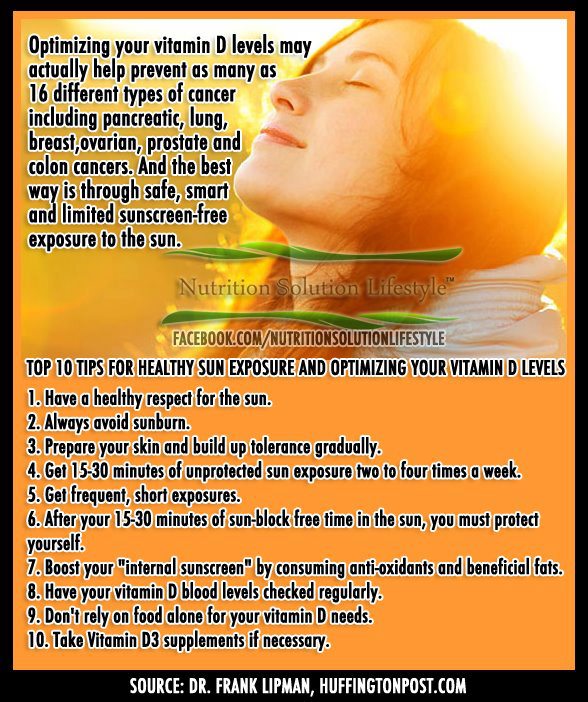 Top 10 Tips for Healthy Sun Exposure and Optimizing your Vitamin D Levels
Top 10 Tips for Healthy Sun Exposure and Optimizing your Vitamin D Levels
1. Have a healthy respect for the sun. It is powerful medicine with potentially dangerous side effects on your skin. Treat it like medication, using the lowest dose necessary, but don’t avoid it completely. Never fall asleep in the sun without protection
2. Always avoid sunburn. It is sunburn, not healthy sun exposure that causes problems. Repeated sunburns, especially in children and very fair-skinned people, have been linked to melanoma. Whereas there is no credible scientific evidence that regular, moderate sun exposure causes melanoma or other skin cancers
3. Prepare your skin and build up tolerance gradually. Start early in the year (spring), or early in the morning before the sun is strongest and slowly build up the amount of time you spend in the sun
4. Get 15-30 minutes of unprotected sun exposure two to four times a week. Each of us has different needs for unprotected sun exposure to maintain adequate levels of Vitamin D. Depending on your age, what type of skin you have, where you live and what time of the day and year it is, your need will vary. The farther you live from the equator, the more exposure to the sun you need in order to generate vitamin D. For instance, a fair skinned person, sitting on a New York beach in June, in the middle of the day, for about 10-15 minutes (enough to cause a light pinkness 24 hours after), is producing the equivalent of 15,000-20,000 IU’s of Vitamin D. But the same person living further north in the U.K, or Canada would need 20-30 minutes to get that light pinkness, which is all one needs. Also, people with dark skin pigmentation may need 20 – 30 times as much exposure to sunlight as fair-skinned people, to generate the same amount of vitamin D. For more specifics, I recommend the tables in The Vitamin D Solution by Dr. Michael Holick
5. Get frequent, short exposures. Regular short exposures have been found to be much more effective and safer than intermittent long ones. Note that you cannot generate Vitamin D when sitting behind a glass window, because the UVB rays necessary for vitamin D production are absorbed by glass
6. After your 15-30 minutes of sun-block free time in the sun, you must protect yourself. If you’re going to be out in the sun for longer periods, wear a hat to protect your face and light colored clothing that blocks the sun and keeps you cool. When you do apply sunscreen, use one with fewer chemicals. Check out the Environmental Working Group’s list of safer sunscreens. Remember that even weak sunscreens block the ability of your skin to manufacture vitamin D, so once you have applied it, you will not be making vitamin D
7. Boost your “internal sunscreen” by consuming anti-oxidants and beneficial fats. These strengthen skin cells, helping to protect them from sun damage. Eating lots of vegetables and fruits such as blueberries, raspberries, goji berries and pomegranates and supplementing with green powdered mixes and fish oils are great options when going into the sun
8. Have your vitamin D blood levels checked regularly. The correct blood test is 25OH vit D or 25 hydroxy vitamin D test. Be aware, however, that current “normal” range for vitamin D is 20 to 55 ng/ml. This is much too low! Those levels may be fine if you want to prevent rickets or osteomalacia, but they are not adequate for optimal health. The ideal range for optimal health is 50-80 ng/ml
9. Don’t rely on food alone for your vitamin D needs. It is almost impossible to get your vitamin D needs met by food alone. Fatty wild fish (not farmed), like salmon and mackerel are the best food sources, but you would have to eat huge quantities of them daily to get anywhere near what your body needs. Although fortified milk and orange juice do contain vitamin D, you would have to drink at least 10 glasses of each daily and I don’t recommend doing that
10. Take Vitamin D3 supplements if necessary. In the winter or if you don’t get enough healthy sun exposure or if your blood levels are low, make sure you supplement with at least 2,000 IU’s a day of Vitamin D3. Although I recommend moderate sunbathing, vitamin D supplements provide the same benefits as sunshine (in terms of Vitamin D needs). But, if taken in too large a dose, they can cause vitamin D toxicity, whereas sun exposure does not. It is impossible to generate too much vitamin D in your body from the sun: Your body will self-regulate and only generate what it needs, which just reaffirms to me that we should get our vitamin D from sensible sun exposure
PLEASE “share” this useful information with EVERYONE that YOU care about.
Source: Dr. Frank Lipman,
Health Inspirations – Tips – Inspirational Quotes, Pictures and Motivational Thought <<<< Wish you Healthy Life ~ Welcome Home >>>>